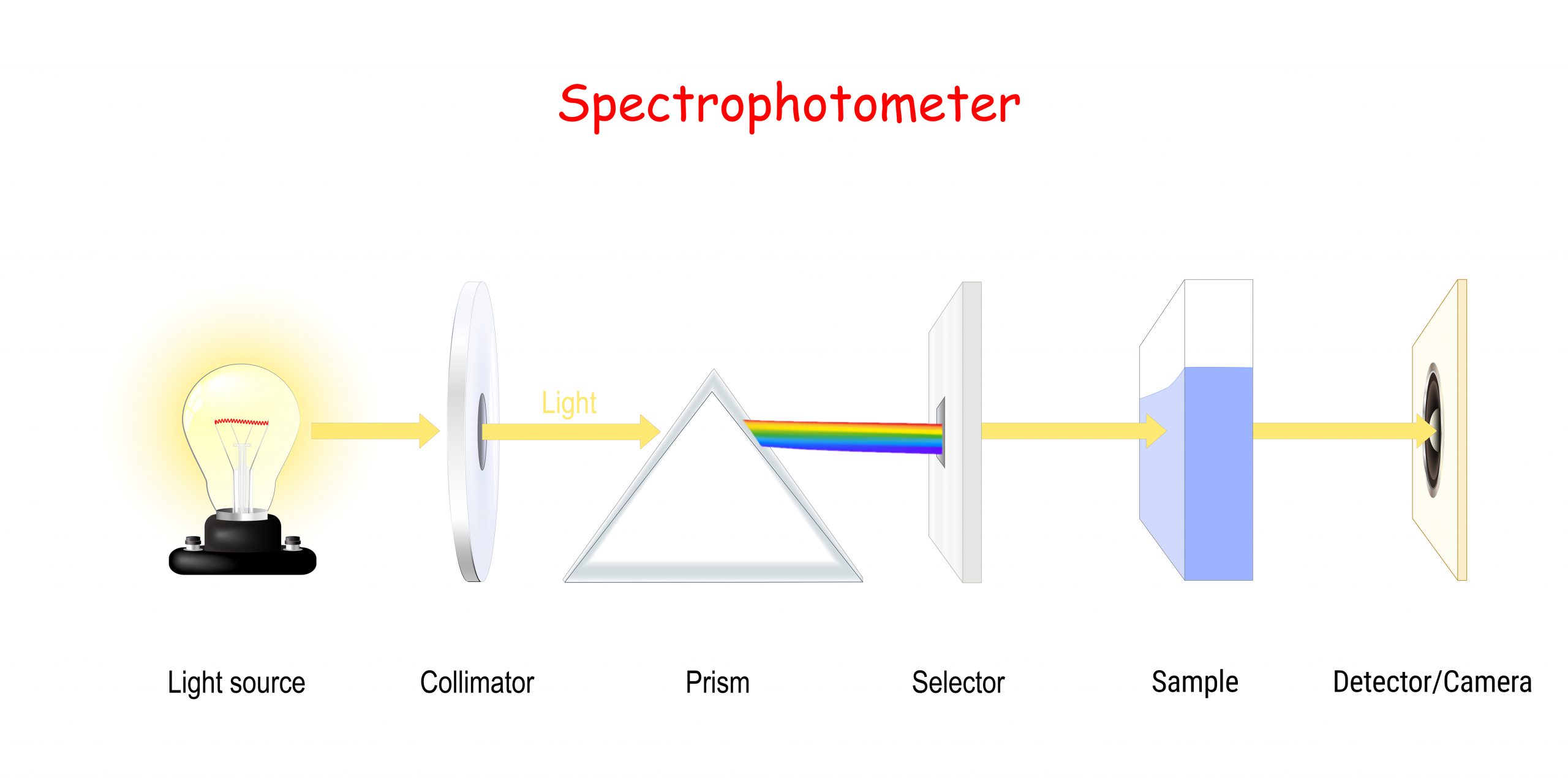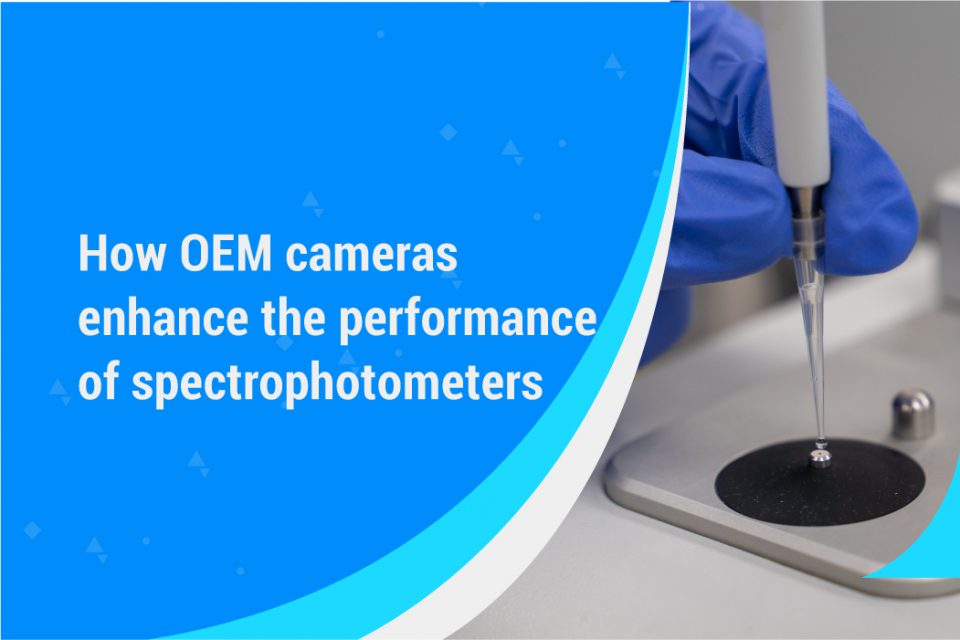A spectrophotometer is a device used to measure the light absorbed by a solution or substance. It is a popular technique used in chemical analysis and medical diagnosis to determine the composition of the test sample. A spectrophotometer typically consists of a light source, diffraction grating, test sample or substance, detector, and a digital display. However, in order to improve the quality of output delivered by the device, many manufacturers today are deploying cameras in spectrophotometers. This is where embedded vision or OEM cameras come into play. Cameras are used in these devices to predominantly check the quality of the solution to be examined. It is done by ensuring that the sample is free of defects such as air bubbles. Cameras also help in checking the accuracy of sample placement. We will talk in detail about the role of cameras in spectrophotometers in a later section.
Spectrophotometers are used across a wide array of applications in industries like biotechnology, pharmaceutical, forensics, medical diagnosis, etc. According to a recent study, the worldwide spectrometry market size was estimated at USD 14.1 billion last year. From 2021 to 2028, the study concludes that the market is expected to grow at a CAGR of 7.2%. Though a vast majority of these devices do not have cameras today, with the competition growing among manufacturers to differentiate in the market, the likelihood of them embedding cameras in spectrophotometers is very high in the coming years.
How do spectrophotometers work?
In the previous section, we learned what are the different components of a spectrophotometer. Now let us look at the basics of how the device works.
Spectrophotometers measure the light strength from the test sample which absorbs light. It uses the light beam passing through the sample, as each compound in the solution absorbs or transmits light over a certain wavelength. Spectrophotometers also measure the number of photons absorbed.
In fact, the process involves two instruments: a spectrometer and a photometer (or the detector). The spectrometer produces the light of the required wavelength. The photometer measures the intensity of light by evaluating the amount of light that passes through the sample.
Before passing through the sample, the light source is optimized using a diffraction grating. The diffraction grating determines the wavelength range. It also partially determines the optical resolution that can be achieved by the spectrophotometer. The light emitted by the diffraction grating is then passed through an exit slit before it falls on the sample.
The below image is a good representation of how the process works:

The above diagram shows the working of a traditional spectrophotometer. However, as discussed before, new gen spectrophotometers come with a camera in addition to the other components to improve sample quality and accuracy.
Types of spectrophotometers
Spectrophotometers come predominantly in two types:
- UV-visible spectrophotometer: It uses a light beam in the ultraviolet range (185 – 400 nm) and the visible range (400 – 700 nm) of the electromagnetic radiation spectrum.
- IR spectrophotometer: It uses a light beam in the infrared range (700 – 15000 nm) of the electromagnetic radiation spectrum.
The following image represents the spectrum of electromagnetic waves spectrophotometers work in:

Why do cameras play a crucial role in spectrophotometers?
A camera acts as the eye of a spectrophotometer. It can serve different purposes like:
- Capturing the reflected light
- Qualifying the sample
- Identifying the position of the sample
Let us now look at each of them in detail.
Capturing the reflected light
A spectrophotometer is commonly used in spectral analysis to assess the level of concentration in purified DNA, RNA, protein samples, etc. So, they have to quantitatively measure the reflection of visible/UV/infrared light with high-resolution imaging capabilities. It is crucial as such applications need the vision firepower to extract accurate spectral data and find out the exact concentration levels.
Qualifying the sample
Cameras are also used in spectrophotometers to verify the purity of samples. Effective cameras speed up the verification process before the samples are used in any downstream sensitive reaction or assay applications. They help navigate past the challenges of the sample being prone to defects like air bubbles. These may prove to be disastrous since they cause measurement inaccuracies, which leads to incorrect results. Hence, embedded camera solutions are used to capture and analyze the image of the sample to check for air bubbles and other inconsistencies before starting the spectral analysis process.
Identifying the position of the sample
Considering that spectrometers involve macro imaging, the camera solution helps identify the exact position of the sample to be analyzed. For instance, with a low distortion miniature lens, you can align the optical resolution with the image resolution to maximize image sharpness. It also avoids image artifacts caused by under-sampling. You can also leverage diagnostics software for measuring image sharpness and fix the best focus position.
If you are interested in learning more about how a camera is integrated into a spectrophotometer in a real life application, have a look at this case study on how e-con leveraged its wide portfolio of cameras and technical expertise to successfully integrate a camera into the spectrophotometer of a global leader in medical devices.
Top 4 considerations while choosing a spectrophotometer camera
Selecting a camera for a spectrophotometer is not a cakewalk. Since it involves ensuring high levels of accuracy in analysis, it is recommended to work with a specialized imaging partner who understands camera technology and has integrated cameras successfully into spectrophotometers before.
Following are the 4 factors you need to consider while choosing a camera for spectrophotometers.
- Spectral range: Depending on the use case, a spectrophotometer needs to use a light source of certain wavelength (UV/visible/IR/NIR), and the camera should support that particular spectral range.
- Resolution: Many spectrophotometric analyses require detailed imaging. The higher the resolution, more will be the details you will be able to capture. However, this doesn’t mean that you have to always go for a very high-resolution camera. For instance, while e-con Systems™ did camera integration for a customer’s spectrophotometer, we went with a 5MP camera module.
- Sensitivity and pixel size: The amount of light that falls on the sensor after passing through the sample will be relatively less owing to absorption. So, the camera has to be highly sensitive to capture sharp images with low lighting. The larger the sensor and pixel size, better would be a camera’s low light performance. A high Quantum efficiency (QE) in a spectrum is a good indicator of a camera’s ability to capture quality images in that spectrum in low lighting conditions.
- SNR and Dynamic Range: Signal-to-Noise Ratio (SNR) and Dynamic Range (DR) are two parameters that are critical for the performance of a camera used in spectrophotometers. A high SNR would mean that the output images have less noise. A good dynamic range ensures that a camera has the ability to capture quality images in varying lighting conditions.
Relevant cameras offered by e-con Systems™ for spectrophotometry and other medical applications
e-con Systems™ offers a wide variety of USB and MIPI cameras for medical devices including spectrophotometers. Following are some of the most popular of them:
- See3CAM_CU27 – Sony STARVIS IMX462 based USB camera with superior NIR performance. Can capture images across a wide spectral range.
- See3CAM_CU55 – 5MP monochrome USB camera. Excellent for applications that require monochrome imaging.
- e-CAM51_USB – 5MP USB camera module with custom lens. Can be used to identify air bubbles/defects with macro imaging
- SeeCAM_CU30 – 3.4 MP low light USB camera for low light and NIR imaging.
Talk to us
Are you a product manager, engineering manager, or hardware engineer working on a vision based medical solution? Come talk to us:
- If you are developing medical devices where the test samples are checked before analysis
- If you need to integrate a macro-imaging vision solution into your medical equipment
- If your current camera partner is struggling to provide a 100% tested product with top-notch manufacturing quality – resulting in RMAs and without delivery delays
- If you want to build a future-ready vision-based medical equipment/device
Click here to connect with us, or write to camerasolutions@e-consystems.com

Balaji is a camera expert with 18+ years of experience in embedded product design, camera solutions, and product development. In e-con Systems, he has built numerous camera solutions in the field of ophthalmology, laboratory equipment, dentistry, assistive technology, dermatology, and more. He has played an integral part in helping many customers build their products by integrating the right vision technology into them.




